Answered step by step
Verified Expert Solution
Question
1 Approved Answer
1. For this question, we assume two lambda terms: W=xy.xyy and I=z.z. (c) Consider the following two Haskell function definitions: encode n= False fx=f(x+1) i.

Step by Step Solution
There are 3 Steps involved in it
Step: 1

Get Instant Access to Expert-Tailored Solutions
See step-by-step solutions with expert insights and AI powered tools for academic success
Step: 2

Step: 3

Ace Your Homework with AI
Get the answers you need in no time with our AI-driven, step-by-step assistance
Get Started


